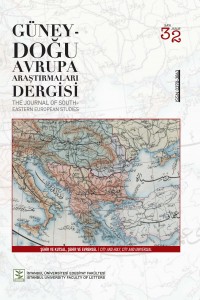Öz
Beyazıt’ta, Süleymaniye Camii ve yapılarına bağlı, Bozdoğan kemerinin kalıntısına yakın konumda, Kaptan Paşa Mektebi sokağı köşesinde 1745 yılında inşa edilmiş olan Ümmü Gülsüm Hatun Çeşmesi, I.Mahmut’un (1730-1754) Sadrazamı Seyit Hasan Paşa’nın (1680-1748) günümüze kadar gelemeyen konağının bahçe duvarının köşesinde yer almaktadır. Toplumsal yaşamın yoğun olduğu kentlerde “kavrama çevremizde” ortak ideallerle ve inançlarla ilgili anıtların dikilme nedeni, manevi değerlerin yaşaması içindir ve bir iletisi (mesajı-bildirisi) vardır. Bu çeşme de işlevsel olmakla birlikte anıtsal bir yapıdır; bulunduğu yerde çevre mekân olgusu yaratarak bölgenin ruhunu etrafa aktarmada ve sahibinin ya da banisinin mesajını iletmede öne çıkmaktadır. Teknik Çağın kalıplarından kurtulmaya çalışan çağdaş insana benzer bir biçimde İslami kalıpların tasvir baskısını bir resim yazı ile kırmaya çalışan sanatçının çabasına işaret etmektedir. Çalışmada Ümmü Gülsüm Hatun Çeşmesi Göstergebilim yöntemiyle ele alınacaktır; Bu, Jakobson’ın dilin başka gösterge dizgeleri içindeki yerini saptamaya yönelik çalışmaları doğrultusunda ve Göstergebilimi özerk bilim düzeyine yükselten Greimas’ın göstergebilimsel dikdörtgeni aracılığıyla gerçekleştirilmeye çalışılacaktır.
Anahtar Kelimeler
Ümmü Gülsüm Çeşmesi Jakobson Greimas Türk Baroku Genius loci Homoludens
Kaynakça
- Aynan, R.E., “Mimarlık-İletişim Bağlamında Mimarın İşine Bir Yaklaşım” (Yayımlanmamış Doktora Tezi, Mimar Sinan Üniversitesi, 1995)
- Aslanyürek,Ş., “16-19. Yüzyıllarda İstanbul Kenti, Türk Toplumu ve Boş Zaman” (Yayınlanmamış Master Tezi, İstanbul Üniversitesi) Cantay,T., “ Ümmü Gülsün Hatun Çeşmesi”, Tarih ve Toplum Dergisi, Eylül, sayı 129, İstanbul, 1994.
- Gibbs, R. W., The Poetics of Mind, New York: Cambridge University Press: 1995.
- Greimas, A.J., Courtés, J., Semiotique Dictionnaire Raisonné du Langage, Paris:Hachette, 1993.
- Güz, N., Göstergebilim Kuram ve Yöntemleri, Yayımlanmamış Ders Notları, Beykoz Üniversitesi
- Huizinga, J., Oyun, Mor Köpük, Ankara: Ayrıntı Yayınları 1986.
- Jay, M., Diyalektik İmgelem, İstanbul, 1989.
- Ögel, S., Çevresel Sanat, İTÜ Mimarlık F. Yayınları, İstanbul, 1976.
- Senemoğlu, O., R. Jacobsen, XX. Yüzyıl Dilbilimi, TDK Yayınları, Ankara, 1983.
- Sihvonen, J., “Public Art and Time” Machineries of Public Art, Turku, 2013.
Öz
In Beyazıt, looking at the ruins of the Bozdoğan arch, attached to the Suleymaniye Mosque and its structures, Ümmü Gülsüm Hatun Fountain, built in 1745 in the corner of Kaptan Paşa Mektebi street, was built by the Grand Vizier Seyit Hasan Pasha (1680- 1748) is located on the corner of the garden wall of the mansion that cannot come to the present day. In cities where social life is diverse and rich “ understanding of environment” the reasons of construction of monuments that are about common ideals and common believes, so there exist the purpose of giving message (concept of understanding) about spritual values and way of living. This fountain is also a monumental structure; It creates a sense of space that surrounds the environment and conveys the environment surrounding the environment and conveys the message of the owner. It also indicates artist tries to break the pressure of Islamic patterns with pictograms as the modern man who tries to break the pressure of the patterns of technical era. In this study, Ümmü Gülsüm Hatun Fountain will be studied by semiotics. This will be done through the work of Jakobson in determining the place of language in other indicator strings and the semiotic rectangle of Greimas elevating Semiology to the level of autonomous science.
Anahtar Kelimeler
Ümmü Gülsüm Fountain Jakobson Greimas Turkish Baroque genius loci homoludens.
Kaynakça
- Aynan, R.E., “Mimarlık-İletişim Bağlamında Mimarın İşine Bir Yaklaşım” (Yayımlanmamış Doktora Tezi, Mimar Sinan Üniversitesi, 1995)
- Aslanyürek,Ş., “16-19. Yüzyıllarda İstanbul Kenti, Türk Toplumu ve Boş Zaman” (Yayınlanmamış Master Tezi, İstanbul Üniversitesi) Cantay,T., “ Ümmü Gülsün Hatun Çeşmesi”, Tarih ve Toplum Dergisi, Eylül, sayı 129, İstanbul, 1994.
- Gibbs, R. W., The Poetics of Mind, New York: Cambridge University Press: 1995.
- Greimas, A.J., Courtés, J., Semiotique Dictionnaire Raisonné du Langage, Paris:Hachette, 1993.
- Güz, N., Göstergebilim Kuram ve Yöntemleri, Yayımlanmamış Ders Notları, Beykoz Üniversitesi
- Huizinga, J., Oyun, Mor Köpük, Ankara: Ayrıntı Yayınları 1986.
- Jay, M., Diyalektik İmgelem, İstanbul, 1989.
- Ögel, S., Çevresel Sanat, İTÜ Mimarlık F. Yayınları, İstanbul, 1976.
- Senemoğlu, O., R. Jacobsen, XX. Yüzyıl Dilbilimi, TDK Yayınları, Ankara, 1983.
- Sihvonen, J., “Public Art and Time” Machineries of Public Art, Turku, 2013.
Ayrıntılar
| Birincil Dil | Türkçe |
|---|---|
| Bölüm | Araştırma Makalesi |
| Yazarlar | |
| Yayımlanma Tarihi | 31 Aralık 2017 |
| Yayımlandığı Sayı | Yıl 2017 Sayı: 32 |

